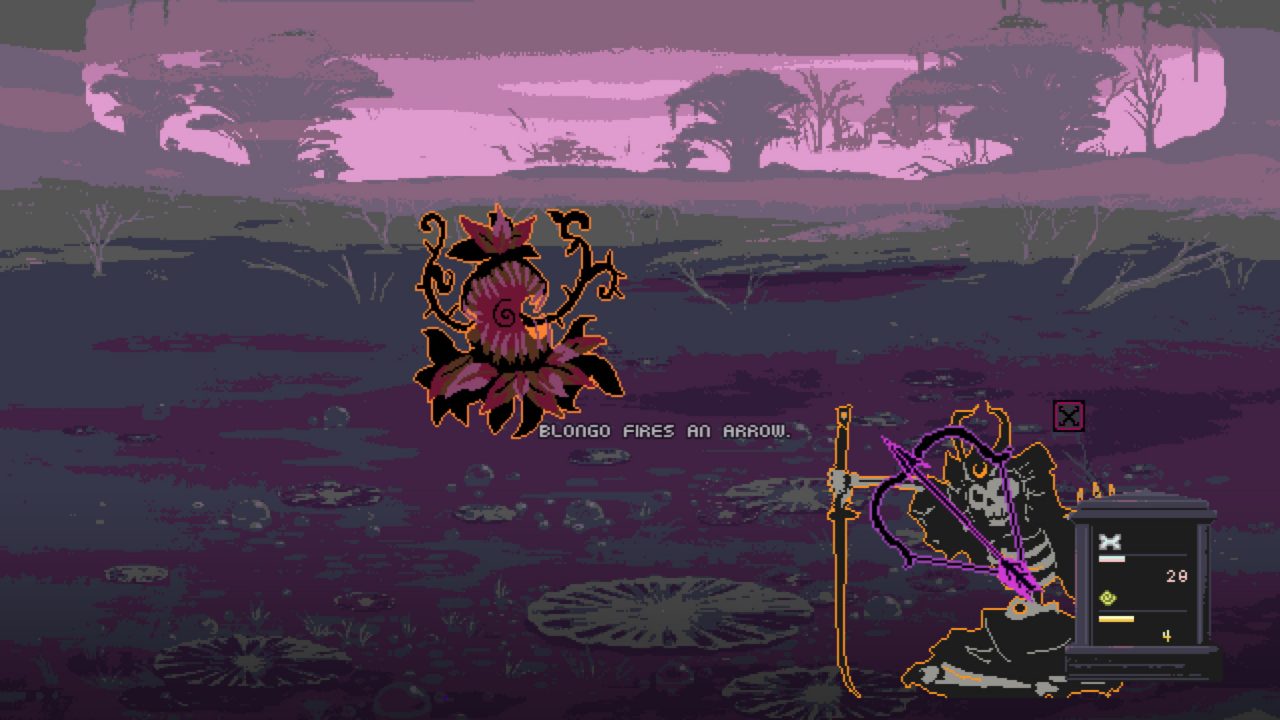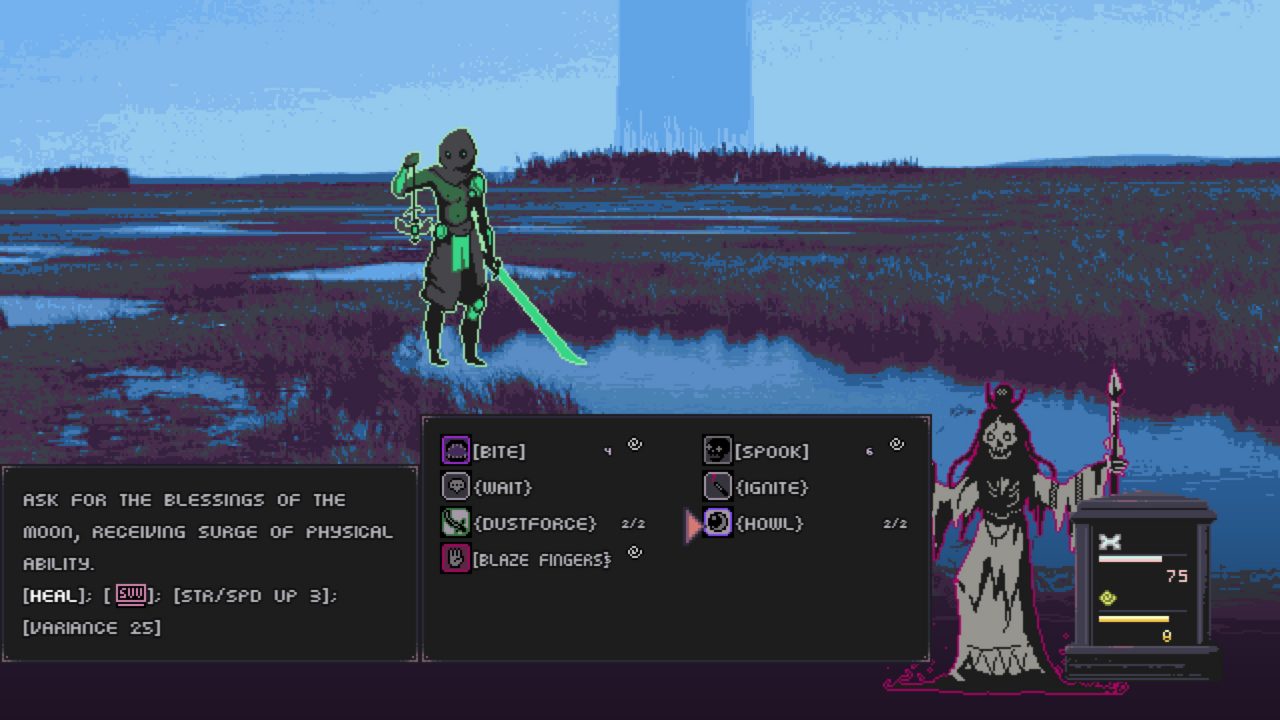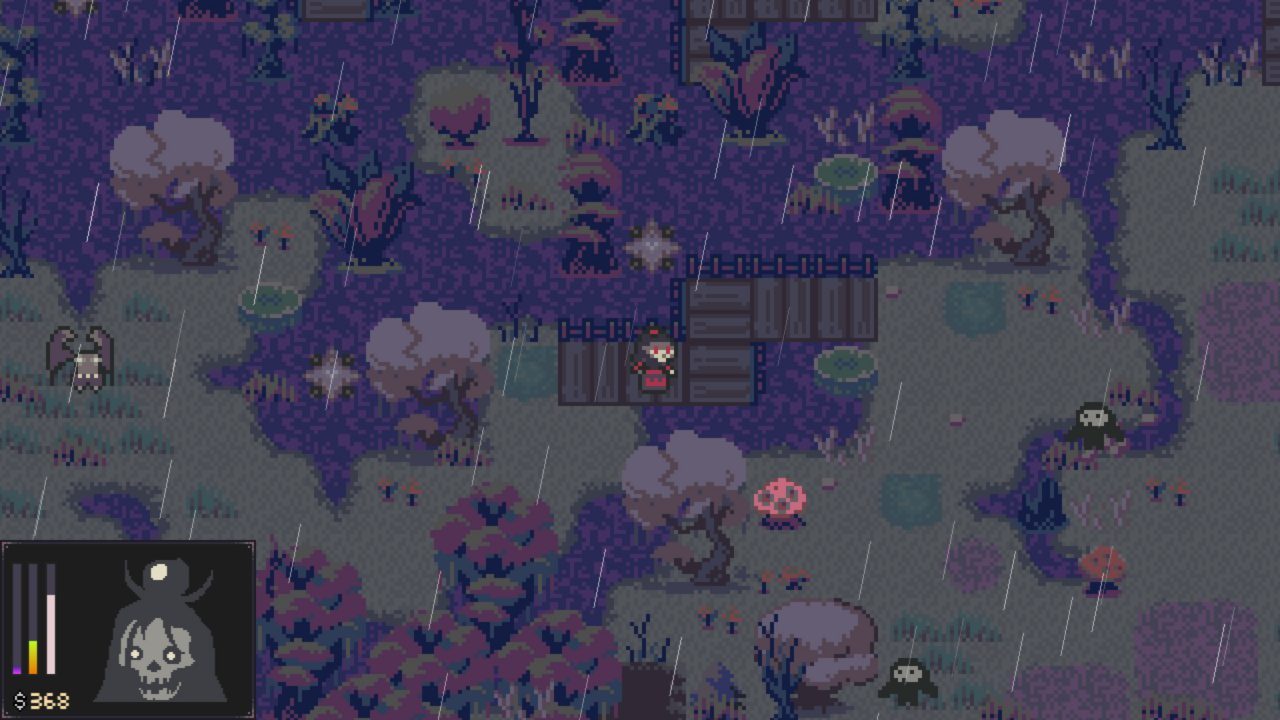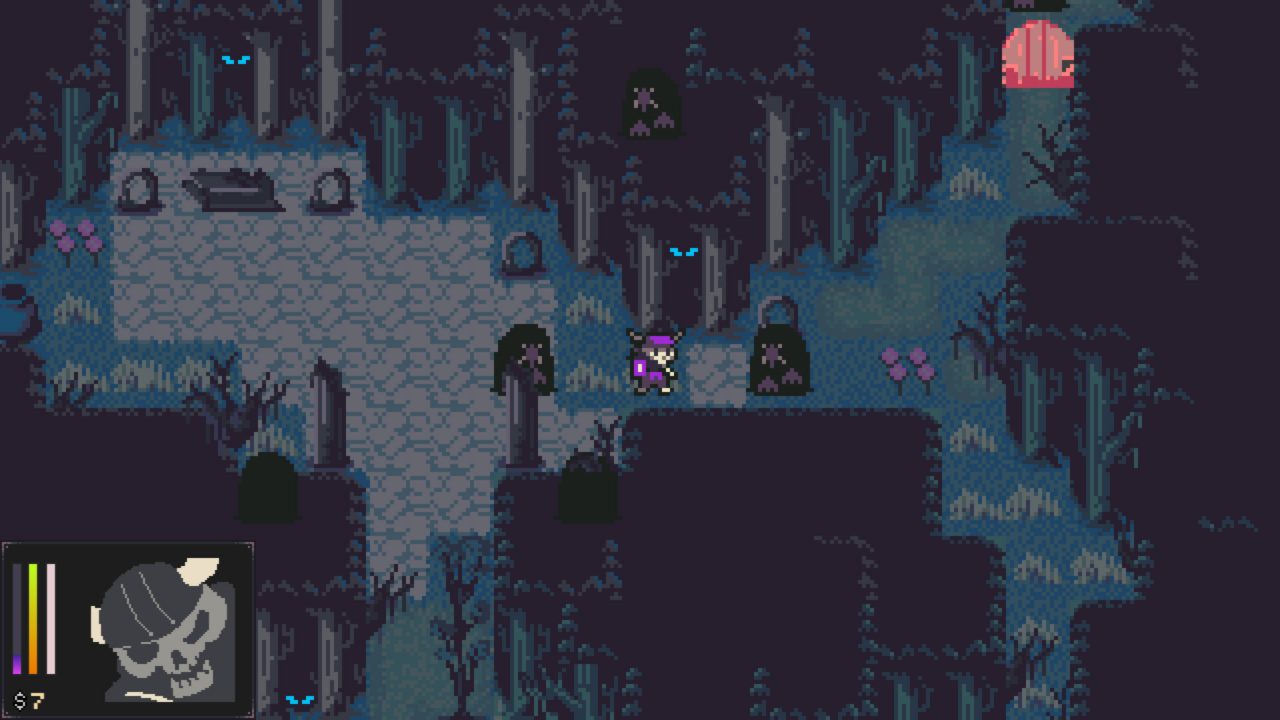In late 2019, indie developer and publisher Moonana released Virgo Versus The Zodiac, a charming JRPG about smiting heretics and murdering constellations. While the full team at Moonana is currently working on the upcoming cyberpunk JRPG Keylocker, the team’s main animator Anglerman released his own game: Osteoblasts. The game is pitched as a dungeon-crawling RPG featuring skeletons with a unique combat system, multiple classes and endings, randomized elements, and a harsh difficulty curve.
Osteoblasts begins with selecting a skeleton for your adventure through the weary world. I went with a samurai based purely on the design, though I knew nothing of the mechanical positives or negatives of either of the remaining classes. Shortly after selecting your name, you’re brought face to face with your creator: Cat Witch. She explains you may call her Witch Cat for short, hinting at how slightly off and weird the residents of this world may be. You’re given a brief explanation of the world around you and tasked with a simple mission to make a delivery. From there, everything goes south figuratively as you trek south literally.
The game has a lot of charm on the surface. In this world, everyone seems to have lost their mind and is either waxing philosophical about the nature of bones, or they simply want to fight you because they don’t know what else to do. Early on, you’re told dogs are harassing skeletons and burying their bones because that’s simply the nature of dogs. While an amusing narrative, there’s not much to it beyond that. I was hoping for more depth and history to the skeleton-dog war, as it’s a hilarious concept surrounding skeletons rising from the grave only to be reburied before the revolution can even begin.

Osteoblasts’ story, unfortunately, leaves a lot to be desired. All the way to the end of the game, I didn’t really know my characters’ goals or motivations. I was simply going from place to place, being told a few things about the world, and then directed elsewhere. Even as I trekked through a tower full of meditating elephants who mused about the Uniformity of Nature, I wondered why I was even there in the first place. Normally, I wouldn’t be concerned, but the protagonist does muse from time to time about who they were before becoming a skeleton. At some point, I even found the land my character came from and the place where they’d died, but nothing came of it. Even the character who sends you on this mission in the first place seems to disappear at some point after telling you to go away.
Osteoblasts takes its biggest risks in battle. It’s a turn-based combat system mostly consisting of static images with some roughly drawn effects to indicate what is happening. Foes are focused on the center-left of the screen while your character sits in the bottom right. You can see your character, but they’re not animated in any way beyond the attack sprites drawn around them. The battle system feels more similar to a first-person dungeon crawler than anything. While that style and presentation of combat is generally my least favorite in games, I don’t feel it’s a negative in Osteoblasts.
There are many wonderful ideas on paper in Osteoblasts‘ combat system. I’m a big fan of the concept of manipulating your stats to gain access to moves you’re not strong enough to use normally, as well as altering your enemies’ stats to remove the ability to use their own moves. However, I don’t think these work as well as I would have liked in execution. Much of the early game involved me unable to use well over half my tools due to enemies stripping me of the Strength that governs attack and defense. The vast majority of my deaths occurred early on thanks to getting outnumbered, shackled with debuffs and status effects, and then beaten to death over and over by dogs with umbrellas and police uniforms.

Regarding stats, Osteoblasts can be confusing with its terminology for them. Bones are considered your replacement for HP, while marrow can be considered SP/MP. Certain moves consume marrow while others restore it, all while working with a cap of 10. This means you may use 6 out of your 10 marrow to do an attack, leaving you with 4. However, you may not have enough marrow left for another attack, and thus must defend or use a move that restores it. While novel, the low cap leads to a lot of downtime in battles that involve you charging up marrow as you get punched in the face by enemies. While Strength was covered earlier, stats like Skill improve counter-attacks. Speed governs the turn order, but even that can be manipulated. Soul and Spite cover magic attack and defense, while Survival determines your healing ability.
Some stats are more straightforward than others, but elements are where Osteoblasts tries to be too unique for its own good. Dust, Rain, Smoke, and Noise are your four elements, though which is weak to which can be confusing. The game relies on colors, though I could never keep it straight. Is green vulnerable to blue? Where does purple come in? What about red? And this white set, Null? It says it’s rare, but what is it strong or weak against? This orange one, Scrap, what even uses that? These were things I asked myself often as I struggled through battles trying to recall what each one did. Attacks on the battle screen list what element they are, but the strengths and weaknesses are buried in the manual. Eventually, I screenshot a piece of the manual and put it up on another monitor for reference when needed.
Despite loving the concepts, the battle system often left me frustrated. I had significant difficulty figuring out why almost every first attack got dodged, why I would sometimes be allowed to act twice in a row, why enemies would get multiple actions against me, or why I would dodge my own attempts to flee battle. I had no way to improve my accuracy. It was a frustrating experience that made battles feel artificially lengthy. Ultimately, the only answer to this problem that I could think of was to shift away from physical moves and turn almost exclusively to magic. I had a spell of each element and shifted all my equipment to be defensive, turning me into a tanky mage. Doing so defeated my concept of a skeleton samurai and made me feel like magic builds were the only viable builds. Stats also become so high that the concept of manipulating them seemed to fall by the wayside.

The narrative and direction in Osteoblasts are spotty at best. I’d found myself constantly lost and wandering through areas with no idea of where I needed to go other than vague statements by crows or NPCs such as “the tower is south” or “the swamp is east.” Numerous locked doors and obstacles impede access to the world, ensuring you hit walls that are intended to make the game feel like a Metroidvania, yet instead feel arbitrary. Many enemies litter the path before you, but some may talk to you. When trying to engage some enemies in combat, an exclamation point would rise above my head along with the text ‘Ambushed!’, though I’m still uncertain if the ambush was being performed on myself or the enemy.
There are a lot of confusing and obtuse elements to Osteoblasts that did little for me. In terms of mechanics, I felt the game went too far in one direction and got away from some basic foundations. By trying to be different from its peers, the game comes off as a muddled mess in terms of the elemental system and general presentation. While I’m the type of person to enjoy mechanically complex systems, I feel erring on the side of simplicity would smooth out the experience of Osteoblasts.
The place where the game shines is in the audiovisual department. The soundtrack, composed by Elektrobear, is atmospheric when it needs to be and chipper when it dares to be. It’s exciting and melancholy, though it’s not afraid to bust out the trombone and get those bones rattling. The art style in the overworld is pleasant and true to its theme, though the art in battle can range from inspired and full of charm to muted and apathetic. The overall package is pleasant to look at and listen to. Thankfully, with a relatively brief experience at just over ten hours, nothing in the game overstays its welcome.

My time with Osteoblasts was a mixture of confusion, frustration, intrigue, challenge, and laughing at the absurdity of what was going on or what I was battling with. While I had fun in some instances, I spent much of my time sighing as I missed yet another attack that would extend battle for another minute or so. There is a lot to like in the game, but it feels like it’s laser-targeted at the crowd who enjoys wandering around dungeons in a masochistic rage. As someone who isn’t the biggest fan of dungeon RPGs, Osteoblasts didn’t quite click with me. That said, despite being a game about skeletons, it certainly has a lot of heart.


